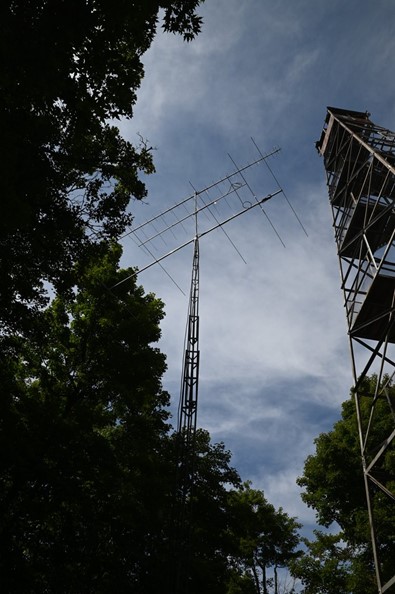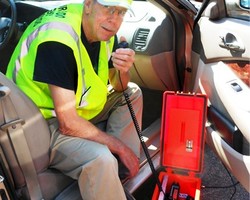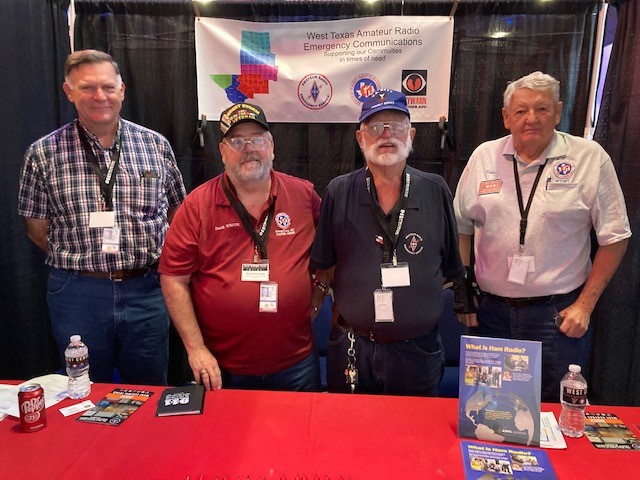 October 18, 2022 Editor: Michael Walters, W8ZY | |||||
Technician Blast Class is a Success There is no "I" in the word "team." We proved this to be true over the weekend of October 8 in Bluefield, West Virginia. The Appalachian Repeater Association and the East River ARC, in association with ARRL and Icom, offered the first-ever Technician Blast Class.
The instructors were: Nelson J. Linkous II, WZ8E; David Sexton, AB8D, and Chris Hatcher, KC8AFH. This class had a number of assistants that provided the classroom space, supplied educational materials, ran errands, brought refreshments, and made a lunch run. Those assistants were Matt Morris, KC8LGS; George Dietrich, KF4YGL; Jay Belt, K8CTI, and Michael Clemons, KM4UCR. The East River ARC VE team scheduled a test session right after the class. A big thanks to Keith Jennings, AD8L; Gary L. Scott, WE3J; Gary Kadar, N8GK; Berlon Roberts, W8ZBR, and Andy Anderson, WD8OOR, for the testing help. There were students that came to the class from as far away as Charleston, Beckley, Oak Hill, and Monroe County. The class produced a 91% pass rate. Those that passed the test were entered into a raffle for the chance to win a Yaesu FT-65 transceiver, provided the Appalachian Repeater Association. The raffle winner was Jason Anderson. Thanks again to everyone who helped us make this Technician Blast Class a success! Cotton Hill VHF Group Activates Fire Tower Members from the Schoharie County Amateur Radio Association, along with members from the Tryon Amateur Radio Club, got together the weekend of September 11 and 12 to put the Cotton Hill VHF Group, WB2UEE, on the air for the ARRL September VHF Contest.
The group chose the Leonard Mountain Fire Tower site in Gilboa, New York, to operate, and they brought the Schoharie County ARA tower trailer along with them, as the fire tower is unavailable at this time. It's reported that the tower is undergoing an engineering review and may be available for use in the future. Their antennas consisted of a 5-element M2 6-meter beam, an 11-element Cushcraft 2-meter beam, and a 23-element 70-centimeter beam. The group set up the operating position at the base of the fire tower. It was a fun time, but it was cut a little short when the rain started late Sunday morning. Either way, it was great fun, and it was nice to put WB2UEE back on the air. There has already been talk of doing more VHF contesting in the future. Other clubs and operators from around the area have expressed interest as well. We look forward to seeing what this group can put together for next season! -- Rocco Conte, WU2M, ARRL NNY Section Manager Volunteer Radio Network Takes Shape San Rafael, CA - During an emergency, being able to quickly send or receive accurate information can make all the difference. However, most standard communication devices require electric power, rendering them ineffective during planned outages, such as the ones that Marin County, California, endured in October 2019. The newly established Marin Radio Communications Volunteers (RCV), a pilot program under Marin County Department of Public Works (DPW), is working toward a solution: organized ham radio communications.
The need was identified by several local amateur radio enthusiasts during the Pacific Gas and Electric Company's Public Safety Power Shutoffs[External] (PSPS) in October 2019. During the PSPS, Marin County's branch of Voluntary Organizations Active in Disaster (VOAD) noted that various community-based organizations had technological problems communicating between each other and several local government agencies. The issues included supply logistics and general assistance, which could have been improved by having a structured network of backup communications, specifically for local organizations. The Marin Amateur Radio Society (MARS) designated ham radio operators who could provide backup communications for the vulnerable community-based organizations. Utilizing mobile radio equipment, the ham operators began looking into effective ways to implement the support network. Soon afterward, the Marin County DPW sponsored the initiative as a pilot program for improving public safety during future PSPS events. A seven-person planning team is collaborating with 16 ham radio volunteers to develop a structured operational system for the pilot program. The guidelines would serve the needs of Marin County's community-based organizations, facilitating basic communications pathways for them to provide their respective services. "We're going for simplicity and functionality," said Skip Fedanzo, KJ6ARL, ham radio operator with Marin RCV. "We want to help local community organizations operate and communicate in an emergency, while letting them focus on doing what they do best: serving vulnerable residents." The pilot program is going through structured tests and simulations to determine which radio frequencies and communications protocols are most efficient and dependable under different situations. Such decisions are being made in conjunction with best practices developed over the 100-year history of worldwide ham radio usage. The volunteers have been running scenario-based drills with the selected organizations to provide proof of concept. The results of the drills and the general operational protocols are expected to be presented to the Marin County Board of Supervisors. If the pilot is successful, the program could scale up to accommodate other community organizations in more locations around Marin County. -- Andrew LeBlanc, Telecommunications Manager and Marin Emergency Radio Authority (MERA) Operations Officer, Department of Public Works West Central Texas Emergency Preparedness Conference
Members of the Abilene area Amateur Radio Emergency Service® (ARES®) and the ARRL WTX Section Manager Eric Durham, W5WI, set up a booth at the West Central Texas Emergency Preparedness Conference, held in the Abilene Convention Center on September 28, 2022. The conference was hosted by the Central Texas Council of Governments and the Texas Division of Emergency Management District 7 Disaster Coordinators. First responders and other emergency personnel from throughout the district attended. Excellent programs on many aspects of emergency operations were presented in breakout rooms. -- Dale Durham, W5WI, ARRL WTX Section Manager Call for Instructors ARRL is embarking on a journey of training for club officers and members. The new club development webinar series will include live Q&A, and the live sessions will be available to everyone. The webinars will be recorded and available to ARRL members through the ARRL Learning Center. We're looking for ARRL members to help us produce, create, and deliver the webinars. The purpose of this program is to offer a series of short webinars that offer training for the skills needed to build and run a successful club. Topics will include leadership, activities, finance, and recruiting. Envisioned is a series of 10 or more webinars, all lasting from 20 to 30 minutes. The hope is that club officers and members will view the series as an opportunity to learn from others that have been able to put those skills to use. To do this, we need the help of membership. We're looking for instructors to help with building the training. We're also looking for members that can present in a standard format and have the skills necessary to do the training. If this sounds like something that you are interested in, please contact Mike Walters, W8ZY, at mwalters@arrl.org for further details. We hope to start this series in late January 2023. Suggestions for Clubs 1. Offer a free year's membership to newly licensed hams, especially if they are kids. But they must show up in person to a club meeting in order to qualify. If they attend a meeting, make sure a mature member is tasked with making them feel welcome and helping them determine what they need to become radio active. If for some reason they never come back, it will have cost the club nothing but the time it took to process their membership form. But if they do decide not to come back, you need to find out why. 2. There's no need to keep all of your print edition's of QST now that you can access them online. So, keep some of them in your car, and when you visit the doctor, barber shop, auto repair place, etc., leave them with all of the other magazines provided at each business for others to browse them while they wait. You should probably use a marker to cross out the name and address, as you would not want to advertise that the addressee has valuable electronics gear at that residence. Better yet, get some Avery® labels to cover up that information. I suggest printing your club's information on the label, such as: "Compliments of the Podunk Valley Amateur Radio Society (www.podunkars.org). We meet every third Tuesday at 7:30 PM at the Podunk Rescue Squad Headquarters Building, 101 Main St. Visitors are always welcome!" 3. If your club conducts test sessions, make sure it has a promotional brochure that talks about the organization. Make sure new licensees are made aware of the free membership offer and the assistance you provide to help them get on the air. Most important: when they show up, smile! -- Raymond "Woody" Woodward, K3VSA (AD, RK), an ARRL-trained Public Information Officer Club Station Update "Club Station," QST's newest column, continues to grow. In the coming months, clubs from around the country will share stories about their activities and programs, such as one Florida club's Field Day operation that included a CW station operated by two blind hams, and an Ohio club offering advice and recommendations on how to successfully put together a club newsletter, among others. "Club Station" is intended to show the successes and contributions of clubs and to highlight how many of them are overcoming the challenges of an ever-changing world to thrive, and to help other clubs do the same. All clubs are invited to submit their story. The details on how and where to submit are located on the Affiliated Club Resources web page, under Club Station Author's Guide and Form. You do not have to be a professional writer to submit your club's story, and QST editors will be happy to work with you. We look forward to hearing from your club! Submitting Info for this Newsletter ARRL Club News is for radio clubs to show how they are working in the community and the hobby to advance amateur radio. If your club completes a project, supports an event, does an EmComm activation, or activates a park, we want to hear about it. You can submit your newsletter article to us at clubs@arrl.org. We like to get them as text or Word files instead of PDFs. If you have pictures, please submit them with caption information, as well as the name and call sign of the photographer. We want to highlight the good work being done by the clubs and show others in the community. Think of this as a chance to show off your club and your programs. How to Plan and Apply for an ARRL Hamfest or Convention If your amateur radio club is planning to host a convention, hamfest, tailgate, or swapfest, please consider applying for it to be an ARRL-sanctioned event. To learn what it means to be an ARRL-sanctioned event, and to get some ideas on how to prepare for and conduct a hamfest or convention, visit www.arrl.org/arrl-sanctioned-events. To have your event sanctioned, complete the online application at www.arrl.org/hamfest-convention-application. The ARRL Hamfests and Conventions Calendar can be found online at www.arrl.org/hamfests. In addition, the Convention and Hamfest Calendar that runs in QST each month also presents information about upcoming events. Important Links ARRL Home: www.arrl.org Find an ARRL Affiliated Club: www.arrl.org/clubs Find your ARRL Section: www.arrl.org/sections Find a license class in your area: www.arrl.org/class Find a license exam in your area: www.arrl.org/exam Find a hamfest or convention: www.arrl.org/hamfests Email ARRL Clubs: clubs@arrl.org | |||||
.jpg)








